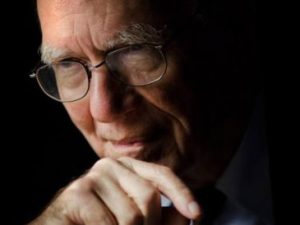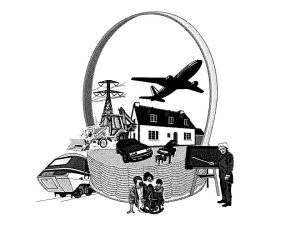En tale af Renée Sigerson ved en videokonference den 12. februar 2022:
I was somewhat surprised, because as Dennis indicated, this was not my particular field of collaboration with Lyndon LaRouche, although I did help on some of the economics projects back in the 1980s. I was sort of curious, but I decided that rather than bothering him about why he asked me to do this, to simply agree to walk with him on what is really this sacred ground. I think for all of us who knew Lyn throughout these years, what he instilled within us as the knowledge of what real economic policy is, was the most profound transformative experience that a human being can possibly imagine going through. Having done that, it really becomes under these circumstances to speak about this, a sacred subject.
It’s also the case that everything we do on behalf of disseminating LaRouche’s work on economics impacts the battle we are at this moment waging for solutions to the existential world crisis. LaRouche’s work on economic forecasting was not about betting on the outcome of events, as has become epidemic in today’s culture; but rather, towards pointing mankind in the direction of what he named “successful survival” from one generation to the next.
In 2005, LaRouche stated in an EIR feature entitled “From Kant to Riemann: The Shape of Empty Space”:
“The ability to predict, or, better said, forecast the physical outcome of man’s behavior, is a subject of a higher, more rigorous form of psychology, and of the social psychology of the sovereign individual mind. This idea of”predicting,” as is the presently customary intention expressed by the use of the word, implies a profoundly incompetent view of man’s role and capabilities within organization of the universe. At best, we can foresee certain important consequences of our decisions, or lack of decision. At best, we can foresee the nature of our obligation to warn our fellows, and to act ourselves in ways which correspond to the problem which we can foresee as probable, even almost certain….
“All attempted prediction, or forecast, of social phenomena, such as economic developments, is essentially … a subject of what might be termed the science of physical psychology: mankind’s relative power of mind within, and over, what is regarded as the physical universe. Therefore, we must think of physical psychology as the kernel of the social psychology of the truly sane individual mind.”
So here we already have presentation of the idea of the individual mind. That individual’s relationship to all of humanity, and of humanity’s relationship to the totality of the universe. This is the domain of real economics, as underlined by Helga’s organizing of the Thursday debate, which involved high-level Russian and U.S. officials grappling with how to end the genocide in Afghanistan and launch an economic development strategy that can help to turn the world at large away from general war. This is exactly the battleground on which Lyn’s discoveries in economics are breaking new ground. In fighting for his approach to economics, we are addressing the development of humanity by addressing the mindset of the individuals who lead society and who are thereby defending the sacred of every individual to develop their God-given creative potential.
When LaRouche began to found a movement around his ideas, roughly in the period from 1968-71, he rapidly came to identified as the most fierce critic and opponent of the academic schools of economics, all of which—both left-wing and right-wing—were advocates of what they called monetarism. That is, all the university economics in the United States and most of the trans-Atlantic world, typified by names such as Milton Friedman of the University of Chicago, or John Maynard Keynes of the London School of Economics, had become under British imperial influence, a cult which fixated on the circulation of money and the fluctuation of money prices as the source of economic activity and the root of some kind of mysterious growth.
LaRouche was fierce in his denunciation of this ideology, which he rigorously demonstrated was a justification for imperial policies of genocide, both globally and within the United States itself. In countering this British game with his work on scientific physical economy in the 1970s, LaRouche triggered a rediscovery of the American System of economics, a name originally adopted in the 19th Century to contrast the American method of Hamilton, Quincy Adams, Lincoln, etc. to the British imperial system. The American System, having been developed from the threads of progress created by the European Renaissance through Kepler, through Leibniz, to the discoveries in economic policy design led by Alexander Hamilton. After the World Wars I and II, nearly all knowledge of the American System of economics, which combined concepts of physical economy to the idea of sovereign credit—which is not the same thing as money—had been buried in propaganda about the U.S. special relationship to Britain and habits of consumerism that horribly corrupted the U.S. political leadership.
Through the influence of the military-industrial complex, and the effects of Kennedy assassinations of the 1960s, not just the memory, but the impulse to think in terms of the principles of physical economy had virtually disappeared. LaRouche did not simply revive past knowledge; he developed the cutting edge of a new fundamental discovery in economic forecasting, which is the preparation for economic development and design. Which cut at the very core of the imperial design which uses fetishes about money and popular opinion to lower the level of mental functioning of thinking within populations. The power of LaRouche’s criticism of monetarism rose from this groundbreaking work on economic forecasting.
As he often highlighted, Lyn’s fundamental breakthrough in developing a method of economic forecasting occurred in the period of 1948-52. His relentless work to that end included intensive study of areas of knowledge ignored by so-called economists. That is, LaRouche connected his work on physical economy and how it is planned in such a way as to succeed in practice, he connected this work to studies of Classical art—that is, music, poetry, and painting, which all address the functional level of the human mind. And as Helga always emphasizes, of human emotions. As well as investigating a form of mathematics developed by the 19th Century scientist Bernhard Riemann, which had served as a companion to Riemann’s work in physics. If there are two people who Lyndon frequently spoke of as critical to his fundamental discovery in economics, most mentioned were the composer Ludwig von Beethoven, who we will discuss in detail in the future, and the other was the physicist Bernhard Riemann.
Riemann’s breakthroughs in economics had emerged as one of the stunning effects of a rebirth of a cultural renaissance that centered around the German-speaking area of Europe during the same time as the American Revolution. Riemann’s outlook on mathematics as the companion to scientific advances in man’s knowledge of the physical universe, was a break with the imperial outlook of the imperial system’s chief ideologues—characters such as Sir Isaac Newton or John Locke and David Hume. For LaRouche, work on physical economy and the ability of mankind to consciously create expanding economies that can support and improve the living standards of growing populations, Riemann’s approach to complex physical processes was invaluable. In fact, an economy is a complex physical process, bringing together a vast array of different components that if they interact, are also continuously changing. How, in fact, can this process be measured to see if it is going in the right direction? This is an old question in astrophysics and even in engineering, which is a serious question. How do you measure something which is moving and changing as you are working with it?
The financial centers have always insisted that this problem, as it relates to what is called economy, should be left to the magic of the marketplace. The imperial monetarists have always argued that to know through science and technology how to increase the output or the productivity of the economy is merely a question of wishful thinking. And the greatest problem economies face is that there are too many people. This is a very old idea that there are too many people. The root of this very sick idea is also very old. It goes back to ancient times, but still grips the corridors of universities and media with all kinds of exotic and mystical explanations tossed in. Most recently, the carbon hoax in order to sell this cultural insanity.
In forming his political movement, LaRouche countered that it was time to discard this genocidal ideology, and to get serious about mastering the principles of scientific and technological progress which pave the way for physical growth of the economy and increases in prosperity for all. Riemann was an invaluable companion in the fight LaRouche launched, and we will look in a moment to an example of how their work came together.
LaRouche became famous in the period from 1968 to 1971 because he was the only economist in the United States who forecast that real estate speculation, the lack of investment in capital goods, the neglect of so-called Third World economies, and interference from the Bank of England were leading to a collapse of the U.S. dollar. When Nixon devalued the dollar in May of 1971, and then ended the fixed exchange rate system known as Bretton Woods on August 15th of that year, overnight LaRouche became the center of tremendous controversy and our organization exploded in recruitment. An earlier 1956-7 forecast of a serious U.S. recession triggered by the postwar consumer credit bubble, including in automobile purchases, had been proven accurate, had gotten LaRouche into political trouble, but was less well known. The two forecasts—1956 and 1968-71—convinced LaRouche that his method of economic analysis worked, and was a vital approach that had to be disseminated for the survival of mankind.
Around 1975, LaRouche’s work became renowned internationally as he launched an international campaign to replace the monetarist and genocidal policies of the International Monetary Fund with the founding of an International Development Bank. Dozens of underdeveloped nations around the world backed LaRouche in this endeavor.
In the 1980s, while working with the Reagan administration in the development of the Strategic Defense Initiative, a spin-off of his work on physical economy, LaRouche commissioned associates to produce a sequence of reports demonstrating the effectiveness of what he named the LaRouche-Riemann economic forecasting method. LaRouche’s ability to recognize the potential for war avoidance in the development of defensive high-energy laser devices was a spin-off of his recognition of the importance of Riemann’s work. During this time in 1982, LaRouche produced a two-part article entitled, “What Is an Economic Shockwave?” It was published in the Executive Intelligence Review and examined the implications for economic policymaking of Bernhard Riemann’s discoveries relative to what were called “hydro-dynamic shockwaves.” Physical shockwaves are complex processes which can be seen in something as ordinary as a crest at the top of an ocean wave; but which Riemann recognized were relevant to many more physical processes. Riemann hypothesized that such examinations of shockwaves would lead potentially to discoveries in the atomic domain, which was still completely invisible in his lifetime. Riemann’s ideas on this matter arose before the work on the atom by such people as Albert Einstein and Max Planck. And his hypotheses were proven later to be right. For example, in an 1859 paper, Riemann anticipated that mankind would come to recognize the importance of sonic booms as an example of such simple shockwaves, such as that we see in the ocean. He outlined that concept before air flight, before man could fly in airplanes, which much later proved that he had been right when the airplanes were developed. Because the phenomenon he suggested, he had been able to discern and think about because it was already audible in thunder, but had never been explained.
In 1982, LaRouche wrote:
“In explaining sonic booms to children, for example, we point out that as an object moves through the atmosphere near the speed of sound, the air becomes very much like water in one respect; it become a relatively incompressible medium, relative to the movement of the body. We say, that as a result, the air behaves, in some significant respects as a hydrodynamic medium, generating the shock-wave we identify as the sonic boom cause by a supersonic aircraft’s flight or a supersonic bullet’s trajectory.
“So far, the whole matter might seem quite straightforward. Therefore, why should there have been any controversy among physicists concerning the conclusions projected by Riemann’s 1859 paper, in which the generation of such ‘sonic booms’ was first analyzed and predicted?
“During the 1890s, Lord Rayleigh, Bertrand Russell, and others insisted that Riemann’s physics was absurd. Rayleigh, in particular, insisted that ‘sonic booms’ could not exist. The reason for that hullabaloo is, that if Riemann’s physics is correct, if sonic booms are generated in such a fashion, then there exists a fundamental absurdity in the kinds of mathematical physics associated with figures such as Descartes, Newton, etc…. In other words, the kind of physics Riemann brought to bear upon his 1859 ‘shock-wave’ paper implies a different kind of universe than the Newton-Cauchy-Maxwell school insists to exist. The organization of the universe if not Newtonian, but is, rather hydrodynamic.
“It is my own chief contribution to scientific work to have discovered and demonstrated, beginning 1952, that the ordering of economic processes corresponds uniquely to the implications of Riemannian physics.” [https://larouchepub.com/eiw/public/1982/eirv09n47-19821207/eirv09n47-19821207_018-what_is_an_economic_shock_wave-lar.pdf]
This is really such a beautiful idea; it’s just really stunning and moving. So, I just want to note a bond so to speak between LaRouche and Riemann was that both were advocates of the early 18th Century scientist Leibniz, who in many respects was the man who triggered the 18th Century German cultural renaissance, but was also a very positive influence over the circles around Benjamin Franklin. LaRouche and Riemann were impassioned defenders of Leibniz’s idea that mankind, through the use of creative discovery, can unlock the necessary and sufficient reason, as Leibniz put it, for all physical effects in the universe. The oligarchical assembly of scientific hatchet men descending from Sir Isaac Newton and others, hated Leibniz, and never stopped denigrating his work to try to prevent mankind from making these discoveries.
During the 1980s, LaRouche’s associates published four economic forecasts, using a preliminary computerized version of the LaRouche-Riemann Method. The reports, accurately forecasted the early 1980s Federal Reserve-induced recession, plus created quite a stir when exposing how the Federal Reserve (surprise, surprise!) had launched a systematic falsification of the industrial output figures on the U.S. economy.
This work with Riemann and the discussion of shock waves was an embedded feature of how Lyndon LaRouche developed his economic development intervention after the Fall of the Berlin Wall. Since at other times, we had discussed in this forum LaRouche’s role in designing what Ronald Reagan named the Strategic Defense Initiative, we will simply reference that aspect. That work on the SDI was critical in the tectonic, shock-wave-like political shift in the global strategic situation, when the Berlin Wall came down in 1989.
As many of our listeners know, when that happened, LaRouche who had called for the Fall of the Wall a year earlier on U.S. television, was ready to seize the opportunity to the benefit of mankind, but was forced to do so while unjustly imprisoned through the machinations of the very corrupt permanent bureaucracy of the Department of Justice. Please keep in mind the initiative I am describing was designed by him while he was being held in prison as a result of a judicial frameup which it took us five years to physically liberate him from. We still need to win the battle for his exoneration, which the winning of that battle will serve, itself, as a tectonic political shock for the good, when that occurs. It will draw tremendous interest into LaRouche’s ideas.
Despite this intolerable situation, LaRouche communicated to Helga and others, his view of the economic policy approach required to ensure that the reunification of Germany would be beneficial to all of Europe, and mankind, and serve to usher in a new era of economic development.
The very first intervention LaRouche made into the economic development of Europe after the Fall of the Wall, was called “The Productive Triangle.” Here is a picture of a map run in 1992, while LaRouche was still in jail, illustrating the area of the Productive Triangle at that time, the most concentrated area in Europe, in industrial production, wedged between the capital cities of Berlin, Paris and Vienna. And you can see that darkened area is a kind of triangular shape that connects Berlin, Vienna and Paris, and it was an area about the concentration in productive potential and population, let’s say, the nation of Japan, and what’s the highest concentration of industrial capacity. And LaRouche’s idea was, this had to be expanded eastward, into Poland, to show that Germany had the best of intentions toward Poland—maybe a little bit difficult for Americans to fully understand how important that was at the time, as a concept. But then to show to the Soviet Union, which still existed when this was first introduced, that such good intention would also be extended to Moscow. And that this would be generated by building very modern, high-speed rail systems in that entire area, including the Productive Triangle itself, which needed a remake in its transportation systems; but into Eastern Europe as a conveyor belt for bringing much more advanced technologies into Eastern Europe, where the population was generally highly skilled and literate, but extremely poor.
While Lyn was incarcerated, our friends in Europe distributed millions of piece of literature, beginning in eastern Germany, but then in many languages extending into neighboring countries, as the Soviet system was unravelling. As Helga has often noted, the Schiller Institute organized hundreds of events to build a human thread of dialogue and collaboration between the united Germany, the best circles in Western Europe, and those in the East who had been cut off from contact for over two generations. There was a tremendously positive response in Eastern Europe to the idea of importing modern rail transport and higher-grade machine tools, to turn Eastern Europe into a workshop, for example, for industrialization of the third world.
Unfortunately, the bankers had a very different agenda for Eastern Europe, so the progress was slow, but the idea was out.
Please put up the second chart: LaRouche indicated that these areas of modern rail transport would become “development corridors”: That wherever modern rail would be constructed, it would serve as the precursor and the foundation for a full-scale improvement in fuel distribution, electrification, construction of modern cities, educational-cultural center, etc. Here we see an early representation of the idea, confined to Western and Eastern Europe, where canal systems are being built in the same area that the rail systems are being modernized. The view of development corridor was a 20th-21st century realization of how the Lincoln Administration used the Transcontinental Railroad project, during the Civil War, not merely to win the Civil War, but to launch the United States as the largest industrial economy the world had ever seen, viewing the rail system as a corridor for upgrading the interior land surface of the United States. It was a huge blow against the imperial obsession that only coastal regions of nations should be developed, an insane concept which derives from very ancient, pagan-like obsessions within the circles of the financial so-called “elites.”
While the idea for the development corridors, beginning in Eastern Europe, with the intention of spreading the concept of a rail grid to Moscow and into Siberia, by perhaps around 1994, it became clear that leading political circles in China were also thoroughly intrigued by LaRouche’s approach and wanted to discuss it. This became the seed crystal for the policy eventually adopted by China as well, which has become the number-one thorn in the side of the financial oligarchy’s existence: Namely, China has assumed a leadership role in connecting by rail the Eurasian Land-Bridge to Asia’s old Silk Road, or newly modernized Silk Road. It is the idea of the development corridor, not just building rail for trade between partners that are far away from each other, but everywhere along the route, to use the rail system as the foundation for a positive, shock-wave development in power production, agriculture, water management, irrigation, modern city building and so forth; and of course, anybody who doesn’t have a copy of our magnificent 2014 report on this, “The New Silk Road Becomes the World Land-Bridge.” You can find it on the Executive Intelligence Review website: https://store.larouchepub.com/New-Silk-Road-p/eipsp-2014-1.htm
We are applying the lessons of such economic development to the crisis in Afghanistan; also to outflank the games the British have been playing endlessly, really since the 1763 Treaty of Paris, which allowed the British East India Company, the predecessors of the Michael Bloombergs and Mark Carneys of today, when they moved at that time to take top-down control of the British government. This is what we have to stop bowing to.
The mobilization we are spearheading to prevent war through economic cooperation requires tough determination, because the pathology we are determined to cure has existed for a long time. LaRouche has addressed this in a number of articles I will not name, but encourage people to find out about, without blunting the force of hearing him speak on the subject, which he thought about for many decades. I will just make reference here to LaRouche’s insight that mankind has always operated under the influence of various cultural economic platforms. The paradox inherent in this situation, is that in order to survive such as the moment when the ice caps melted and very suddenly scattered civilizations which had largely lived by travelling long distances along low-level ocean beds—we’re talking 20,000 years ago—such civilizations were suddenly forced to inhabit permanent settlements on land. These maritime cultures, LaRouche stated, exhibited a “pattern of social caste division between a maritime population which has the characteristics of those often termed the relatively ancient ‘gods,’ as distinct from the mere mortals.” This division in society were a small, powerful elite that has greater control over some resources and technologies, convinces the mere mortals, that they, the guys with the access to the technology, are the gods who control your life. This is an ancient characteristic, sometimes called by Helga LaRouche a “childhood disease of civilization.”
The reality is that every human being that is born, is a potential genius, and capable of adding to the wealth of knowledge and practical benefit of the totality of humanity. Moreover, as the technologies we require increasingly become related to exploration and habitation of space, and the universe at large, it will become impossible for the bores and pleasure-seeking degenerates from the oligarchic grooms who are leading controlled popular opinion in order to keep their power. The type of knowledge the average person can, and will gain to live in such a civilization which is involved in massive exploration and study of the universe, will crush the authorities of those who say, “mankind is an animal incapable of mastering the principles of the physical universe.”
The current fight to develop Afghanistan to end the campaigns of genocide that have followed in the wake of all of these so-called “endless wars,” provides the needed opportunity to spread LaRouche’s economic method worldwide, thereby, we create the political and moral shock wave, that can restore morality based on love of our fellow man, and respect for the immortal rights of every mortal beings.







